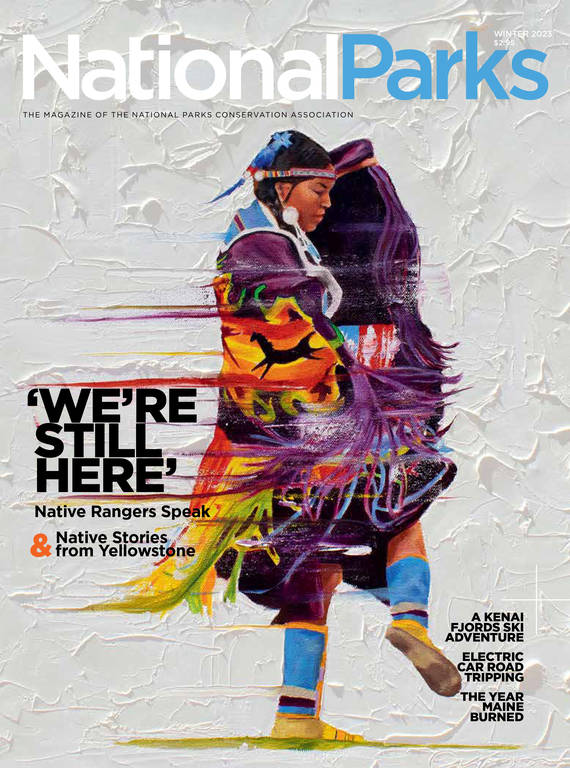Winter 2023
We’re Still Here
Every national park site sits on ancestral lands. So what does it mean to be a Native American working for the Park Service today?
“I am not an artifact,” said Albert LeBeau III, an archaeologist and cultural resource program manager at Effigy Mounds National Monument in Iowa. “I’m a human being.”
LeBeau, a member of the Cheyenne River Sioux Tribe, is forthright about the painful misperceptions he and other Native Americans working at the National Park Service confront on a regular basis. He points to everything from casual word choice to agency decisions that relegate Tribes to the past rather than acknowledging their present-day vibrancy and diversity. Take, for example, Dorothy FireCloud’s 2020 appointment to the post of Native American Affairs liaison within the Park Service, he said. LeBeau and others had to fight to keep her position out of the Cultural Resources department. “We’re not a resource,” he said. “Don’t put us under Cultural Resources.”
THE DIRECTOR SPEAKS
LeBeau believes exposure to an Indigenous perspective is the simplest way to preempt these sorts of missteps. But elevating Native voices requires the presence of Native voices — no small task in the Park Service, where this demographic makes up a slim fraction of the workforce. Despite the agency’s efforts to diversify, only 2.5% of its 20,000-plus permanent, seasonal and temporary employees identify as Native American or Alaska Native.
Inevitably, Indigenous staff members face a host of challenges, underpinned by an uncomfortable truth: They are working — and living, in some cases — on lands that were, for the most part, illegally seized by the same entity that signs their paychecks. Many feel torn between representing the U.S. government in their Park Service uniforms and representing the sovereign nations to which they belong. Others say they struggle with a sense of isolation. Some recount instances of federally mandated Tribal consultation (regarding decisions that affect culturally significant areas of parks) that were perfunctory and failed to alter the outcome. At the same time, exhibits, signs, brochures and maps rarely paint the full picture of parks’ Native history. And while some parks are working to expand this narrow narrative, chronic underfunding can halt novel interpretation and cultural preservation efforts before they start.
On the other hand, significant strides have been taken by the Park Service in recent years, Indigenous staffers say. Native Americans — for the first time — now lead both the Park Service and the Department of the Interior. Federal guidance encourages national parks to open their doors to traditional plant gathering. Grassroots campaigns to remove names that glorify perpetrators of past atrocities or that are based on ethnic slurs have finally gained traction. And a recent agreement between five Tribes and the federal government to jointly manage Bears Ears National Monument sets a promising precedent for co-stewardship of public lands.
But how much will this visible momentum buoy the individual park employee and how much of it is political posturing? And in this fraught landscape where personal and professional lives blur and unremedied wrongs cast long shadows, how do these staff members walk the line between activism and duty, frustration and hope?
Read on for the candid perspectives of five Park Service employees who wish to remind the world that their stories and their cultures endure, or as LeBeau so pointedly said: “We’re still here.”
RAVIS HENRY
Navajo/Diné
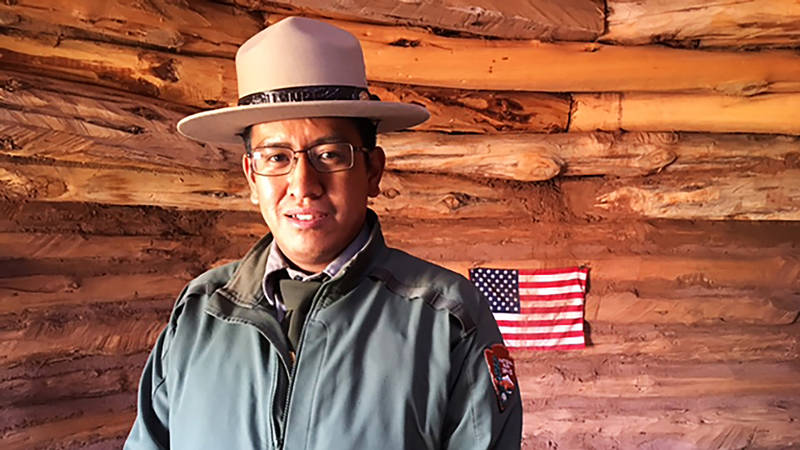
Ravis Henry.
©LAUREL MORALES“Ya’at’eeh. My name is Ravis Henry.”
Henry was sitting in his parked car, wearing a crimson ball cap and black-framed glasses. Rather than diving straight into the video interview, he paused to introduce himself according to Navajo custom. After giving his English name, he proceeded in Navajo, explaining who he is by explaining who his family is, where he comes from, where he lives and which clans he belongs to. He called himself “Tséyi’nii tsíłkę’,” which, he said, translates to “a young person of the canyon.” His introduction, he said, “establishes kinship” with other Navajo.
Henry’s family has lived in the Canyon de Chelly for generations. Their home, hemmed in by 900-foot sandstone walls, lies 9 miles from the canyon mouth. In this oasis, they raise livestock, tend crops and produce a profusion of fruit in their orchards. They are one of around 40 families who reside within Canyon de Chelly National Monument.
Today, ownership of the land on which the park sits — just shy of 84,000 acres, including the totality of three canyons — remains with the Navajo Nation, as it has since time immemorial. “A lot of visitors come and say, ‘Oh, the park allows people to live here,’” Henry said. “And I turn that around: ‘No, the people and the Navajo Nation allow the park to be here and want the park to be here.’”
Essentially, I represent three different people. And all three don’t always see eye to eye.
Growing up as the eldest of eight, Henry recalls being carried on his mother’s back as she’d walk down White House Trail and set up her wares — jewelry and crafts — to sell to tourists. While his mother was occupied, Henry would run off to splash in Chinle Wash, if it was flowing, or join games with the other children. He knew people liked to visit his home and that his great-uncle was a park ranger. Beyond that, he knew almost nothing about the Park Service.
That began to change when, as a teenager, he started accompanying his father on the guided tours he led for park visitors. (Because the park is on Tribal land, non-Navajo visitors must have a Native guide to explore the backcountry.) Then in 2009, after a stint at Northern Arizona University, Henry started volunteering at the park. His now-supervisor encouraged him to apply for a seasonal job, which turned into a permanent ranger position in 2012.
Thanks to Henry’s gift for storytelling and his knowledge of Tribal relations, he’s been detailed to other parks, including Haleakalā National Park in Hawaii and Sitka National Historical Park in Alaska. He also spent a month in 2017 at Great Sand Dunes National Park and Preserve in Colorado where he found himself — for the first time — in the minority as one of the few Indigenous employees.
Over the years, the 34-year-old’s appreciation for Canyon de Chelly’s predominantly Navajo staff has only deepened. He dreams of a day when other parks have more Native American representation. “That’s one of the things I would like to see,” Henry said. “More Indigenous people in the green and gray sharing their own stories, managing their own parks, fighting and working for their people, for these sacred places.”
Henry’s identities as a park ranger, Navajo Nation member and Canyon de Chelly resident can be tricky to balance. When park or Tribal decisions need to be made, he often finds himself biting his tongue. “Essentially, I represent three different people,” he said. “And all three don’t always see eye to eye.”
In recent years, Henry’s commitment to carrying forward what he calls the Navajo lifeways has led him to dive headlong into the role of storyteller for his people and to apprentice with an uncle who is a traditional medicine man. “Our language and our culture — our identity — are on the verge of being lost,” he said.
That’s why, though he’s open to working anywhere in the National Park System, he’d like to stay within an eight-hour drive of the canyon. If circumstances demand, he could start out at daybreak and be back before nightfall. “I’m grounded to my home,” he explained. “I’m grounded to my people.”
JARED WAHKINNEY
Comanche
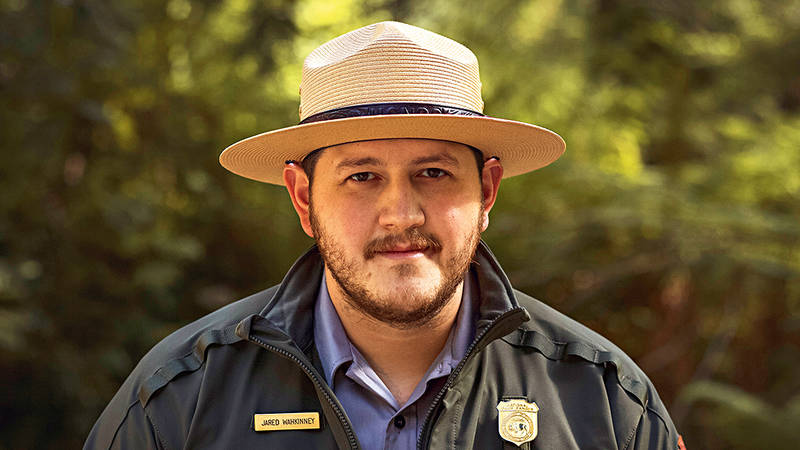
Jared Wahkinney.
COURTESY OF JARED WAHKINNEYJared Wahkinney comes from a long line of dispatchers. In fact, his last name means “camp crier” in Comanche, “and here I am as a modern-day camp crier,” he said in an interview in May.
The ebullient Oklahoman arrived at Mount Rainier National Park in early 2021, a novice to the field. As he plunged into the fast-paced world of park news, traffic stops, backcountry rescues and odd antics (including a domestic sheep that survived for two months in the park before being captured and re-homed), he came to appreciate the importance of his role. “I’m literally communicating with everybody in the park,” he said. “What can I do to help them?” He also began to identify with relatives who served as Comanche code talkers in World War II and his father, who carried on the family legacy when he did a stint as a dispatcher in the U.S. Air Force.
Raised by a Comanche father and a Scottish mother, Wahkinney grew up surrounded by tales of his paternal relatives’ movements across the Rockies and into the Plains. “Understanding these lands and where we come from was a huge part of my upbringing and really guides what I do,” he said. It wasn’t until a sunset detour to the Grand Canyon during a three-week STEM trip with the Native Explorers Foundation in his mid-20s, however, that national parks blinked to life on his mental map of the American West. Prior to that, he said, “I just didn’t know that they were out there.”
The desire to help other Native youth have their own park epiphanies drove Wahkinney, the father of two, to participate in an initiative called Mountains to Main Street in 2018. Through that program, which supports young leaders as they connect their communities to local parks, Wahkinney took a group of Comanche college students to Chickasaw National Recreation Area and Washita Battlefield National Historic Site in Oklahoma. Participants explored their relationship to park land, learned about career opportunities and traditional uses of plants, and erected a teepee. The following year, Wahkinney snagged an internship at Grand Teton National Park, a place he considers “the main hub” of his ancestral lands.
While stationed in the Northwest, the 30-year-old sometimes struggled with the irony of being a Native American working for an agency that manages the spoils of government dispossession. “It’s hard being in an area that’s ancestral land,” he said. “Even if it’s not to me, I know it’s ancestral land to somebody else.”
Understanding these lands and where we come from was a huge part of my upbringing.
Still, Wahkinney has also witnessed the slow churn of change. “I think right now the Park Service is engaging with Tribal communities in a different way,” he said, pointing to the increasing respect for traditional ecological knowledge. He partly ascribes the shift to the presence of Indigenous employees in positions of power, such as Park Service Director Chuck Sams and Secretary of the Interior Deb Haaland.
“Where does it go from here?” he asked. “How do we begin to work with these Tribes to be better for them and their communities and their use of the parks?” In the future, he pictures park and Tribal leadership collaborating on equal footing, government to government, and co-managing park units. “I would love to see that happen,” he said.
Wahkinney left Mount Rainier this fall to serve as a park guide at Oklahoma City National Memorial and Museum.
ŠINÁ BEAR EAGLE
Oglala Lakota
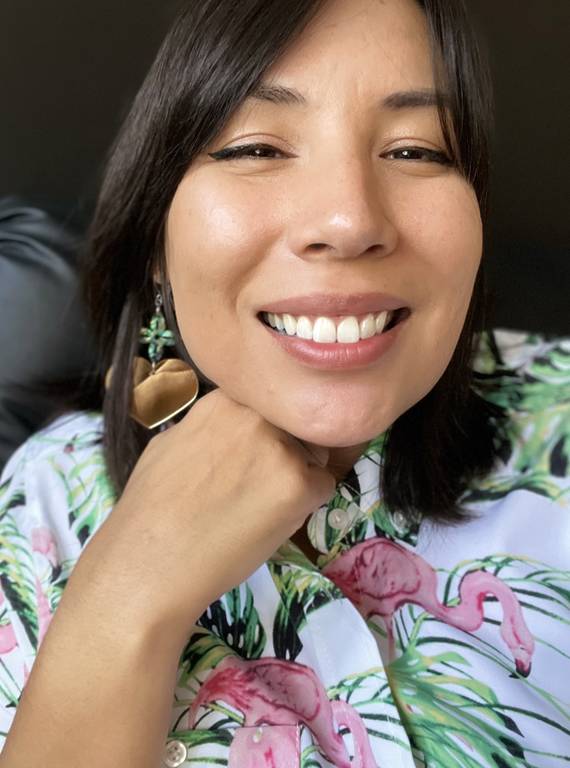
Šiná Bear Eagle.
COURTESY OF ŠINÁ BEAR EAGLEA sleek cat tail whipped in front of Šiná Bear Eagle’s computer camera as she described her unconventional path to the Park Service. “It was actually an accident,” she said. “I had no intention to work for the Park Service.”
Though more than 130,000 acres of the windswept prairies and spirelike buttes of Badlands National Park sit on the Pine Ridge Indian Reservation where she was raised, Bear Eagle was an adult before she realized part of her homeland was a national park. She was similarly unaware of the federal status of other nearby places, such as Bear Lodge (officially Devils Tower National Monument) and Wind Cave National Park, site of her people’s emergence story. “When we visited these sites,” she said, “it wasn’t because we were going to national parks. It was because we were going to places that were important.”
She stumbled into a job at Wind Cave after a friend spotted a Park Service recruitment table in 2013 at the Lakota Nation Invitational, a sporting and academic event, and wrote a Facebook post about the importance of Lakota people working in the Black Hills. Bear Eagle’s whirlwind first few weeks as a seasonal ranger quickly dispelled the notion she’d had that the park was merely a “local thing.” Other revelations followed. As she waded through unfamiliar bureaucracy and learned the insider terminology, it slowly dawned on her that she was the first Indigenous person many of her teammates had met. That was occasionally frustrating — “it’s a privilege not to be a representative of your race, to be honest,” she said — but it also motivated her, especially when it came to bringing her perspective to the park’s outdated interpretation. She noticed that the linear timeline in the park’s museum labeled everything prior to 1881 as “prehistory” and included a cursory reference to Native Americans discovering a breathing hole in the ground. She took exception to the simplification of Wind Cave and to the term prehistory. “It’s not history before white people are involved?” she asked.
It’s a privilege not to be a representative of your race, to be honest.
Bear Eagle, who has since earned a master’s degree in American Indian studies, also realized that her fellow interpretive rangers had little grasp of the Native American presence in the area. (Today, more than 20 Tribes are associated with the park.) When a colleague asked her to switch tours because someone in his group wanted to hear about the Lakota emergence from Wind Cave, she was irked but ultimately sympathized. “He was kind of set up to fail,” she said, because the park hadn’t equipped him with the resources to tell that story.
So, Bear Eagle rolled up her sleeves. She led several staff trainings about Native American history in the area, which had the added benefit of preparing her colleagues to face visitors who treat rangers as a proxy for the U.S. government when they have grievances to air. “The Black Hills are still an extremely contested area,” she said, referring to the bitter battle between the Lakota people and the U.S. government in which a 1980 Supreme Court ruling determined the Black Hills (known by the Lakota as “the heart of everything that is”) had been illegally taken from the Tribe in 1877. The government awarded cash compensation for the value of the land, but the Lakota refused the money, having never agreed to cede the Black Hills in the first place. “If Lakota people are unhappy with the rangers,” Bear Eagle said, “the rangers deserve to know why.”
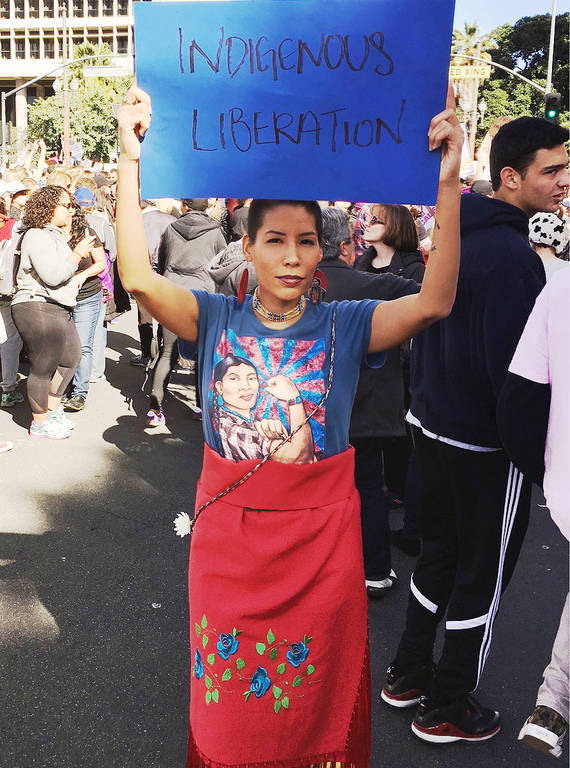
Bear Eagle at a demonstration in 2017.
COURTESY OF ŠINÁ BEAR EAGLEShe also drafted a more complete account of local Indigenous history for the museum display panels and addressed the outdated timeline by consulting with Tribal elders and commissioning a winter count — a pictorial calendar that represents the Lakota emergence story — to replace the chronology on the museum wall. Bear Eagle even undertook the sensitive task of documenting the emergence story. “The problem with writing something down is it then becomes almost like a canon, which is not the way that oral histories work,” she said. She explained how the story she tells has continued to evolve and how the act of giving it breath gives her rendition life. Despite her initial reservations, Bear Eagle decided that recording a version of the tale and permitting the video to be posted on Wind Cave’s website would benefit those Lakota, park staff and visitors who’d never hear it otherwise.
Though she left the park in 2018 to work at other sites, from Grand Canyon National Park to Gateway National Recreation Area, her connection to Wind Cave eventually led her back. This fall, she took up a one-year temporary position there as a cultural training specialist.
She speaks reverently about first walking into the cave as a child 25 years ago. “My hands were shaking as I walked down the stairwell,” she said. “I could just feel the power of that place.” Overcome with a desire to permanently connect herself to Wind Cave, Bear Eagle left a few strands of her hair in the honeycombed cavern. Because the Lakota people believe that one’s spirit is connected to one’s hair, her long-ago tribute was her small way “to ensure that my spirit and my soul would come back to that place,” she said.
ETHAN WHITE CALFE
Mandan, Hidatsa and Arikara
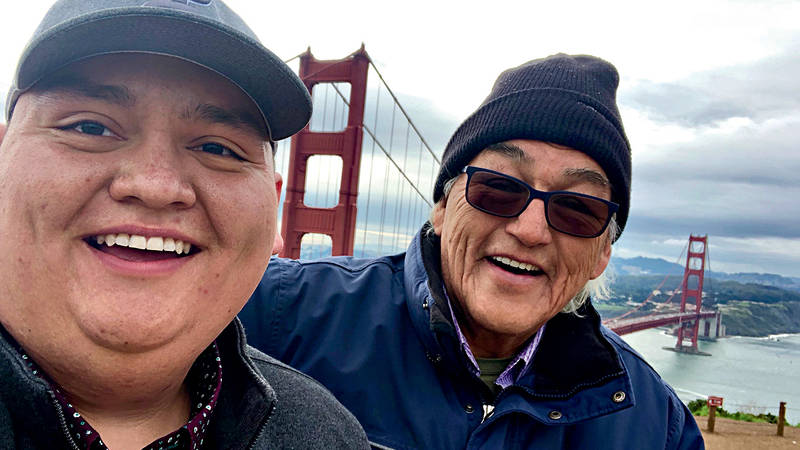
Ethan White Calfe with his grandfather Gerard Baker.
COURTESY OF ETHAN WHITE CALFEEthan White Calfe wears many hats. He’s co-owner of a family cattle ranch that lies mostly on Fort Berthold Reservation land in North Dakota. He’s a part-time painter, blending modern motifs with designs he’s seen on parfleche items (rawhide containers fashioned by Plains Indians). He’s an NPCA volunteer, serving on the organization’s national council and elsewhere over the years. He’s also the grandson of Gerard Baker, who was the highest-ranking Native American in the Park Service at the time of his retirement in 2010.
And while his three older siblings trod a path into the medical field, White Calfe followed in Baker’s steps, landing a seasonal internship at Knife River Indian Villages National Historic Site, what he calls his “home park,” in 2012. He spent several six-month stints at the Missouri River site before securing gigs at Grand Teton and Yellowstone national parks and, this summer, Glacier Bay National Park and Preserve, where he doffed his cowboy boots and found his sea legs.
Like Ravis Henry and others, White Calfe envisions a day when there are many more Indigenous people telling their own stories from their own homelands. Until then, he said, “I try and make it my mission to go to these places and tell the stories that weren’t being told about the people who were there and how they lived.” This frequently involves after-hours research, informal interviews and, ultimately, securing permission to share the words entrusted to him.
Occasionally, there are hard realities he feels need telling. As an interpretive ranger in Yellowstone, for example, he regaled tourists with the saga of the bison’s brush with extinction. “The federal government slaughtered the herds” as a way to force Native Americans to cede lands and accept treaties, White Calfe said. Drawing attention to this as a federal employee was a little “weird,” he admitted, but his supervisors supported him. He recalls being told: “We’re here to interpret the truth even if it doesn’t paint us in the greatest light.”
During his time with the Park Service, he’s accumulated a few anecdotes about how not to work with Tribes — namely, belatedly and with a predetermined course of action in mind — but he was inspired by what he saw at Glacier Bay over the summer. The 29-year-old spoke animatedly about the park’s increased collaboration with the Huna Tlingit people and how a building dedicated in 2016 — Xunaa Shuká Hít, or simply the Tribal House — serves as a cultural anchor on the shores of Bartlett Cove. “It’s a place where they’re always able to come back and say, ‘This is my home, here in this place,’” he said.
I try and make it my mission to go to these places and tell the stories that weren’t being told.
White Calfe especially appreciates how the Park Service encourages interpreters to use Native monikers when referring to landscape features at Glacier Bay. This stands in stark contrast to what he saw in parks in the lower 48, such as Yellowstone, where some landmarks bear the names of “notorious Indian killers and bison killers,” and it can feel like Indigenous footprints have been wiped off the land, he said.
It’s little surprise then that one of his grandfather’s most visible accomplishments — leading the effort to secure a 1991 name change for Little Bighorn Battlefield National Monument — is a source of family pride. (The park was previously named for Lt. Col. George Custer, who led the U.S. Army in a failed 1876 charge against a contingent of Arapaho, Cheyenne and Lakota.) Angry opponents leveled death threats at Baker when the proposal was under consideration. “But he knew he was in the right, and he went through with it,” White Calfe said. “I think that that’s pretty amazing.”
White Calfe’s seasonal position at Glacier Bay ended in September. He has since returned to North Dakota.
ALBERT LEBEAU III
Cheyenne River Sioux
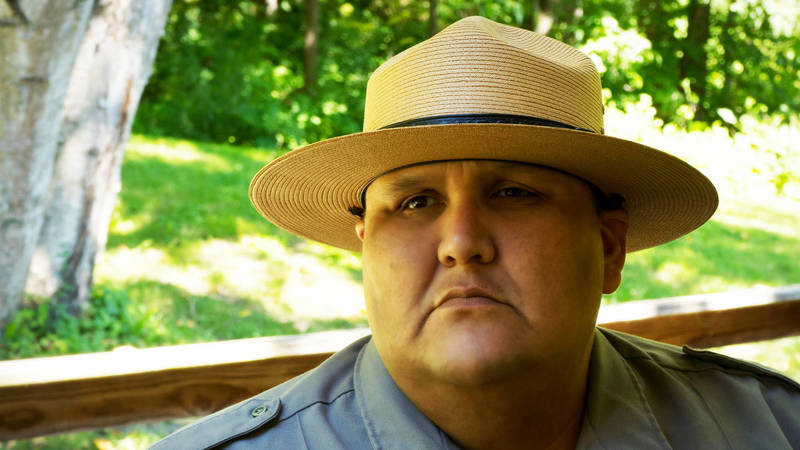
Albert Lebeau III.
NPSAlbert LeBeau III likes to tell people that, as a Native American archaeologist, he’s an oxymoron. He has spent his professional life reconciling two worlds: an archaeological world founded on neat categorization and a Native world indelibly tied to oral history and tradition; a world in which he works for a federal agency and a world in which he is, in his own words, “a ward of the United States government.” (Like many Native Americans in a federally recognized Tribe, LeBeau has a number assigned to him by the Bureau of Indian Affairs. The Certificate of Degree of Indian Blood distills his family tree to a blood quantum. “I’m pedigreed. Like an animal,” he said. “So are my grandkids.”)
LeBeau, 47, grew up in South Dakota on the poverty-stricken Cheyenne River Reservation. He was exposed to death at an early age, losing family members and friends to violence, accidents and suicide. More recently, 22 relatives died of COVID-19. LeBeau also was deeply influenced by the intergenerational trauma inflicted on his family by the forced boarding of Native American youth at faraway schools, a practice that extended into the 1960s and directly affected some 100,000 children. “My father and grandmother are boarding school survivors,” LeBeau said. “The stories they told me about boarding school — and those are the ones that are PG, family-friendly stories — are horrible.”
My heart starts racing, my hands start sweating, when I find an artifact.
Despite their own scarring experiences, LeBeau’s parents and grandparents prioritized education — both what could be learned through traditional avenues (that is, oral history as shared by the Tribe) and through the American school system. He found the latter, which he calls being “European educated,” to be woefully lacking. He recalls opening a history book in high school and finding only a handful of chapters on Native Americans. “This isn’t right,” he remembers thinking. “I know this isn’t right.”
He considered becoming a historian, partly to challenge this blinkered view of the past, before settling on the field of archaeology. Digging in the dirt like his childhood idol Indiana Jones, LeBeau decided, would grant him a greater understanding of who came before, what their lives were like and why they did what they did. “That’s where history starts,” he said. “Real history comes from boots on the ground.”
LeBeau’s three decades as an archaeologist include 15 years with the Park Service. Before arriving at Effigy Mounds in 2013, he worked in Nebraska out of the Park Service’s Midwest Archaeological Center and traveled to more than two dozen parks, from the forts of Kansas to the Apostle Islands in Wisconsin. He loved learning about these places, and he loved the clarity of his mission: “All I had to do was get up and go to work and dig a hole,” he said with his trademark humor and self-deprecation.
The patience LeBeau developed while painstakingly excavating and processing artifacts paid off when he arrived at Effigy Mounds and walked into a managerial quagmire. The site is only now regaining Tribal trust after a former superintendent illegally removed 41 sets of human remains from the park in 1990. (The repatriation process is ongoing.) LeBeau said it took him and his former supervisor nearly a decade of transparency and fence-mending to reestablish credibility.

National Parks
You can read this and other stories about history, nature, culture, art, conservation, travel, science and more in National Parks magazine. Your tax-deductible membership donation of $25 or more entitles…
See more ›At times, LeBeau finds being one of the agency’s few Native Americans “mind-numbingly isolating.” He credits an employee working group that he co-chairs with routinely talking him down from the metaphorical ledge. CIRCLE, which stands for Council for Indigenous Relevancy, Communication, Leadership and Excellence, allows park staff “to kind of decompress and be ourselves and talk to each other in a manner that isn’t prescribed,” he said.
In the end, though new challenges arise and some old obstacles persist, LeBeau keeps showing up for work for one simple reason: He loves his job. “As an archaeologist, I still get a thrill,” he said. “My heart starts racing, my hands start sweating, when I find an artifact.” Whether it’s a lithic scraper or just a flake of stone, he cups it in his palm and thinks: “The last person to see this was probably my ancestor, 4,000, 5,000, 6,000 years ago,” he said. “That is awesome.”
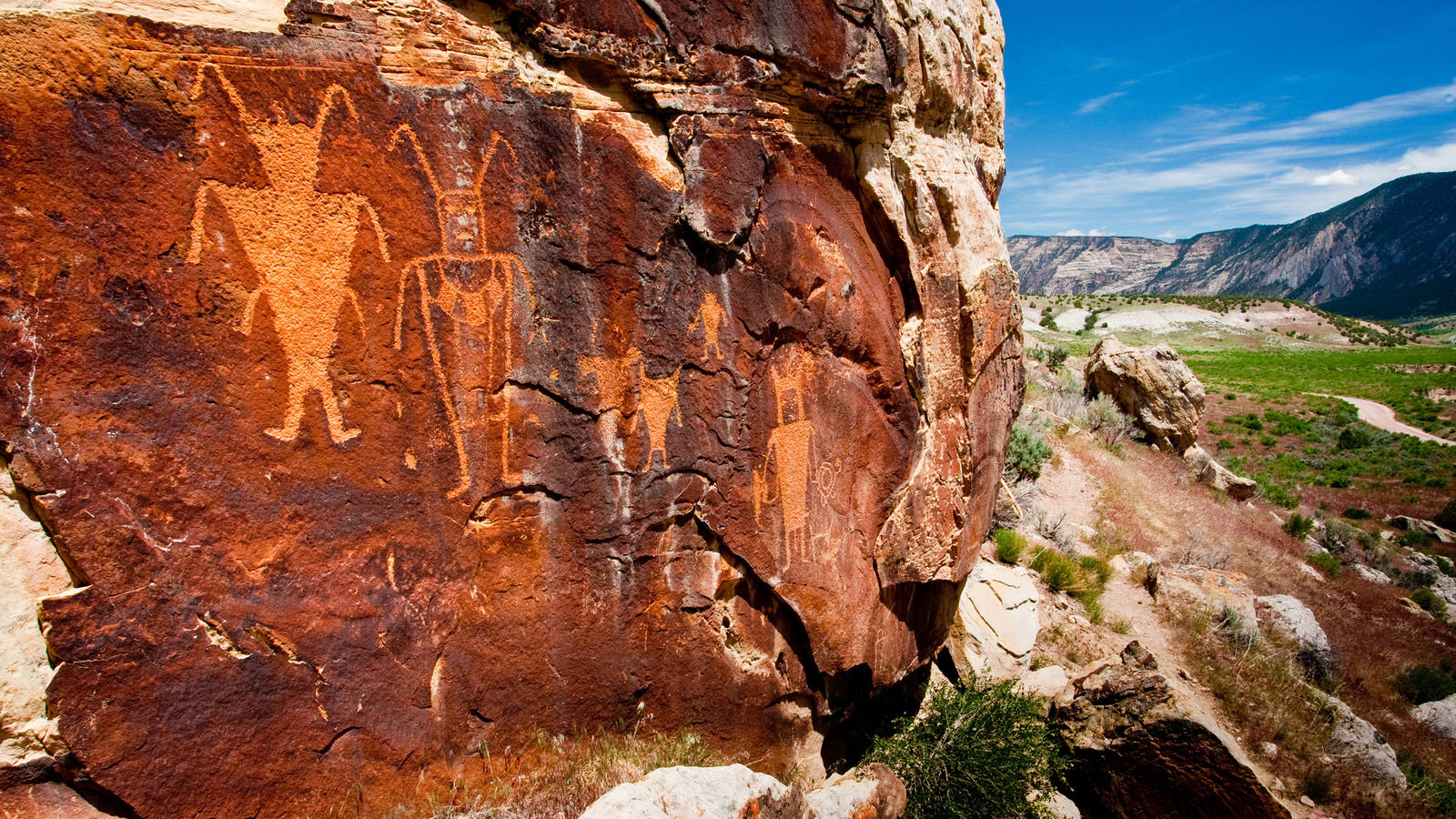
spotlight
National Parks Are Native Lands

About the author
-
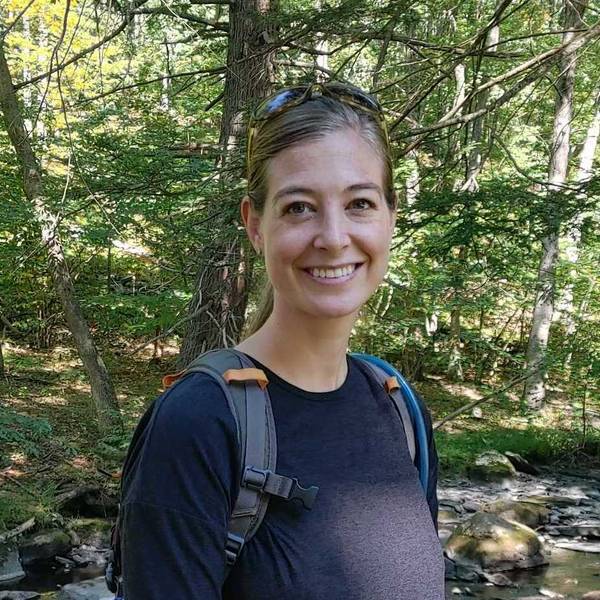 Katherine DeGroff Associate and Online Editor
Katherine DeGroff Associate and Online EditorKatherine is the associate editor of National Parks magazine. Before joining NPCA, Katherine monitored easements at land trusts in Virginia and New Mexico, encouraged bear-aware behavior at Grand Teton National Park, and served as a naturalist for a small environmental education organization in the heart of the Colorado Rockies.
